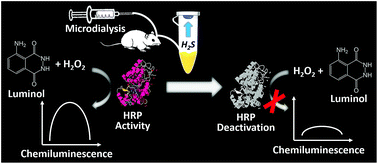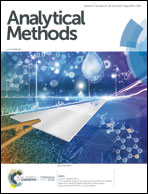Chemiluminescent sensor for hydrogen sulfide in rat brain microdialysis based on target-induced horseradish peroxidase deactivation
Abstract
The detection of hydrogen sulfide (H2S) is important due to its role in the diagnosis of many diseases since H2S is involved in the protection of neurons from oxidative stress and neuronal transmission modulation in the brain. Chemiluminescence (CL) detection methods have the characteristics of simple equipment and high sensitivity. Although many CL methods have been reported for sulfide detection, but nearly all methods detect the total amount of compounds containing sulfide. In this study, a simple but sensitive CL sensor was developed to only detect H2S. A strong CL intensity was found in the luminol/H2O2 system catalyzed by horseradish peroxidase (HRP). The presence of H2S can cause the deactivation of the HRP, resulting in the reduction of the CL intensity of the luminol/H2O2 system. The decreased CL intensity had a linear relationship with the H2S concentration in the range of 0.78–40 μM with a detection limit of 0.30 μM (S/N = 3). The proposed method was applied to detect H2S in rat brain microdialysate with satisfactory results.

- This article is part of the themed collection: Analytical Methods Recent HOT articles


 Please wait while we load your content...
Please wait while we load your content...